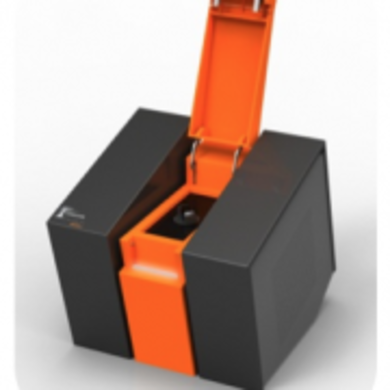- Trang chủ
- Về chúng tôi
- Sản phẩm
- STAKPURE
- VIAVI
- CORDOUAN TECHNOLOGY
- Cryste
- FORMULACTION
- LABINDIA
- HERMLE
- ILSHINBIOBASE
- SCHMIDT HAENSCH
- SFE-Process
- LAMY RHEOLOGY
- PLASMA TECHNOLOGY
- VAN DER HEIJDEN
- SERSTECH
- HOBERSAL
- FRIMED
- DOSATEC
- NEWTRONIC
- BAKER
- NANOMAGNETICS
- ANSEROS
- ALPHA MOS
- TECHNOFOUR
- DISTEK
- OMVE
- WOOWON
- ECODYST
- ILSHIN BIOBASE
- UNOPEX
- PTK
- INORA
- FPS
- EMCO
- ETSP
- AAPPTEC
- DEVOTRANS
- SHASHIN KAGAKU
- PULSEMASTER
- JACOMEX
- Shikoku Instrumentation
- ACCURA Pharmaquip
- ProUmid
- Thermtest Instruments
- FREWITT
- Ứng dụng
- Thông tin và Công nghệ
- Liên hệ
MÁY PHÂN TÍCH THẾ ZETA
Model: Wallis
NSX: Cordouan - Pháp
WALLISζTM is an innovative high resolution Zeta potential analyzer purely dedicated to nanoparticle and colloidal charge characterization.
- Based on a modern version of Laser Doppler Electrophoresis (LDE) technique
- Ideal tool for studying colloidal suspension’s stability and nanoparticles’ electrophoretic properties
Key benefits

- No electro-osmosis → Artifact-free measurements
- Improved LDE technology → Efficient, reliable & simple
- High-resolution measurement → Accurate & repeatable Zeta potential analysis
- High durability electrodes → robustness & cost-effectiveness
- Designed for standard disposable and quartz cuvette → Easy-to-fill, compatible with organic solvents and high-pH suspensions
- Advanced software functionalities (Time, pH, Temperature kinetic modes, SOPs, reporteditor, etc.)
- Easy-to-use and intuitive Graphical User Interface (GUI) software
Technologies & innovations

Dip cell : simple, robust, artifact-free
- Simple and easy sample preparation ; no risk of bubble
- Robust : high durability vitreous carbon electrodes
- Artifact-free : optimized dip cell electrodes design → no electro-osmosis bias
- High resolution measurements : sampling frequency 30 times higher than competitors / significantly improving measurement resolution down to 0,1 mV
Main characteristics
- Zeta potential measurement range: -200mV to +200 mV
- High resolution measurement: better than 0.1 mV
- Dip cell with unique high durability amorphous carbon electrodes
- ZetaQ proprietary software (lien vers onglet ZetaQ)
- Compliant with ISO 13099-2 Colloidal system – methods for Zeta potential determination – Part 2
Zeta potential (ζ)
Is a fundamental property of colloidal suspension related to the effective surface electrical charges of particles immersed in a solvent.
ζ measurement is very important because it gives an indication on formulation stability and electrophoretic properties of NPs. Zeta potential is measured by the well-known technique of Laser Doppler Electrophoresis.
Laser Doppler Electrophoresis principle :

An alternative electrical field/voltage is applied between two electrodes immersed deeply in the colloidal suspension; the charged particles are forced into a translation motion (electrophoresis) with a speed (ν) proportional to the applied electrical field. The electrophoretic mobility is defined by the ratio between the particle speed and the applied field amplitude.
Specifications:
|
Specifications |
|
|
Zeta potential range |
-500 mV to 500 mV |
|
Mobility range |
10-10 to 10-7 m2/V.s |
|
Particle size (For zeta measurement) |
1 nm up to 100 µm |
|
Sample concentration |
0.0001% to 10% w/% (solvent dependent) |
|
Temperature control range inside the cell |
10°C to 70°C +/-0,1°C (depending on cuvette cell material) |
|
Cell options |
Cuvette cell with optical quality windows compatible with organic solvents |
|
Sample volume |
Typically 750 µL (Hellma cell – 10 mm light path) |
|
Maximum sample conductivity |
300 mS/cm |
|
Sample Type |
Aqueous & organic solvents – pH: 1-14 (depending on cuvette cell material) |
|
Signal processing |
|
|
Measurement technology |
Laser Doppler Electrophoresis (LDE) |
|
Laser source |
Highly reliable 20 mW diode @635 nm coupled to automated optical attenuation system. Other wavelengths available upon request |
|
Measurement angle |
Single angle for Zeta potential at 17° |
|
Data processing algorithm |
Fast Fourier Transform |
|
Resolution |
Mobility = 10-10 m2/V.s or Zeta = 0,1 mV ( in water) |
|
Detector |
Avalanche Photodiode – APD |
|
General |
|
|
Computer interface |
USB 2.0 – Windows XP, Seven |
|
Dimensions |
33 cm x 33 cm x 38 cm (HWD) |
|
Weight |
16 kg |
|
Power |
100-115/220-240 VAC, 50/60 Hz, 100 W max |
|
System Compliance |
|
|
CE certification |
ISO 13099-2 : 2012 – Colloidal system – methods for zeta-potential determination – Part 2 : Optical methods |




